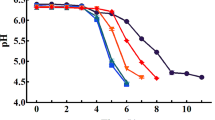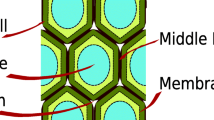Abstract
Cauliflower is a rich source of proteins, carbohydrates, vitamins and minerals and also a very important vegetable having maximum availability in tropical climate from November to February which causes glut in the market and consequently producers do not get remunerative prices. The partially blanched cauliflower pieces of 3–4 cm long having stalk upto 2 cm in length are steeped in different levels of sodium chloride (NaCl, 2–6 %) and acetic acid (1–2 %) along with 350 ppm sulphur dioxide (SO2) using modified response surface methodology (RSM). The cauliflower samples steeped in 4 % NaCl, 1 % acetic acid and 350 ppm SO2 were rated best with maximum mean overall acceptability (OAA) score (6.90) and minimum mean preference (6.25) to the experimental run consisting of 6 % NaCl, 2 % acetic acid and 350 ppm SO2 was noted after 120 days of storage. There has been sharp decrease in pH values after 15 days of storage in all the experimental run of preserved cauliflower samples. The maximum mean decrease in hardness values (15.20–0.55 g.cm) was obtained in steeped cauliflower samples consisting of 6 % NaCl, 2 % acetic acid and 350 ppm SO2 during storage for 120 days at room temperature. The decrease in extent of browning, ascorbic acid and total carotenoids content in cauliflower samples was reported in all the experimental runs during 120 days of storage at room temperature. The optimum concentration for maximum desirability in the preservation of cauliflower consisted of 3.5 % sodium chloride and 1.1 % acetic acid and 350 ppm SO2.


Similar content being viewed by others
References
Aggarwal P, Kaur R (2010) Steeping preservation of baby corn. Int J Veg Sci 16:103–117
Ahn HJ, Kim JH, Kim JK, Kim DH, Yook HS, Byun MW (2005) Combined effects of irradiation and modified atmosphere packaging on minimally processed Chinese cabbage (Brassica rapa L.). Food Chem 89:589–597
Barwal VS, Rakesh S, Rajinder S (2005) Preservation of cauliflower by hurdle technology. J Food Sci Technol 42:26–31
Bose TK, Som MG, Kabir J (1993) Cauliflower. In: Vegetable Crops in India. Naya Prokash, Calcutta, pp 152–169
Chandra P, Kar A (2004) Post harvest processing for developed India. International seminar on emerging technologies in agricultural and food engineering, IIT, Kharagpur, India, December 14–17, 2004
Cocci E, Rocculi P, Romani S, Rosa MD (2006) Changes in nutritional properties of minimally processed apples during storage. Post Harvest Biol Technol 39:265–271
Girdharilal G, Siddappa S, Tandon GL (1986) Preservation of fruits and vegetables. ICAR, New Delhi
Gupta AK, Tomar MC, Singh UB, Singh S (1992) Steeping preservation of red chillies for the preparation of stuffed chilly pickle. Indian Food Packer 46:47–52
Gupta MK, Sehgal VK, Sadhana A (2011) Optimization of drying process parameters for cauliflower drying. J Food Sci Technol. doi:10.1007/s13197-011-0231-5
Gupta S, Chatterjee S, Vaishnav J, Kumar V, Variyar PS, Sharma A (2012) Hurdle technology for shelf stable minimally processed french beans (Phaseolus vulgaris): a response surface methodology approach. LWT Food Sci Technol 48:182–189
Indian Horticulture Database (2010) In: Mistry NC, Singh B, Gandhi CP (eds) Facts and figures. Ministry of Agriculture. Govt of India, Gurgaon, p 4
IS 1479 (1960) Methods of test for dairy industry. Part I. Rapid examination of milk. Indian Standards Institution, New Delhi
Jayanthi M (2005) Innovative solution to extent the shelf life of fruits. Process Food Ind 9:37–38
Karpagapandi L, Kalaiselvan A, Selvi J, Arokiamary S (2006) Phytochemicals a good source to eat plenty of vegetables and fruits. Process Food Ind 9:22–25
Klin M, Nagy S (1988) An improved method to determine non-enzymatic browning in citrus juices. J Agri Food Chem 36(6):1271–1274
Lawless HJ, Haymann H (1998) Consumer field test and questionnaire design. In: Champan H (ed) Sensory evaluation of food. CRC Press, New York, pp 480–518
Leistner L (1985) Hurdle technology applied to meat products of the shelf stable product and intermediate moisture food types. In: Simatos D, Multon JL (eds) Properties of water in foods in relation to quality and stability. Martinus Nijhor, T. Dordrecht, pp 309–329
Lima AGB, Queiroz MR, Nebra SA (2002) Simultaneous moisture transport and shrinkage during drying of solids and ellipsoidal configuration. Chem Eng J 86:85–93
Mudgal VD, Pandey VK (2007) Dehydration characteristics of cauliflower. Int J Food Eng 3(6): Article 6. doi: 10.2202/1556-3758.1278
Pruthi JS, Saxena AK, Manan JS (1980) Studies on the determination of optimum condition of preservation of fresh vegetables in acidified sulphited brine for subsequent use in Indian style curries etc. Indian Food Packer 34:9–16
Ranganna S (1997) Handbook of analysis and quality control for fruit and vegetable products. TataMcGraw hill Publication Co Ltd, New Delhi
Rodriguez R, Agarwal PC, Saha NK (1983) Physico-chemical characteristics of some cauliflower cultivars and their suitability for canning. Indian Food Packer 37:67–73
Shashidhar R, Dhokane V, Hajare S, Sharma A, Bandekar JR (2007) Effectiveness of radiation processing for elimination of Salmonella typhimurium from minimally processed pineapple (Ananas comosus Merr.). J Food Sci 72:98–101
Sinha J, Chandra R (2012) Microbial, sensory and nutritional properties of cauliflower preserved by hurdle technology. Int J Curr Res Rev 4:74–80
Snedecor GW, Cochran WG (1967) Statistical methods. East West Press, New Delhi
Srivastava GK, Sulebele GA (1975) Dehydration of cauliflower: effect of pretreatments on rehydration characteristics. Indian Food Packer 29:5–10
Author information
Authors and Affiliations
Corresponding author
Rights and permissions
About this article
Cite this article
Singh, S., Singh, A., Singh, V. et al. Steeping preservation of cauliflower with hurdle concept. J Food Sci Technol 52, 1350–1360 (2015). https://doi.org/10.1007/s13197-013-1135-3
Revised:
Accepted:
Published:
Issue Date:
DOI: https://doi.org/10.1007/s13197-013-1135-3




